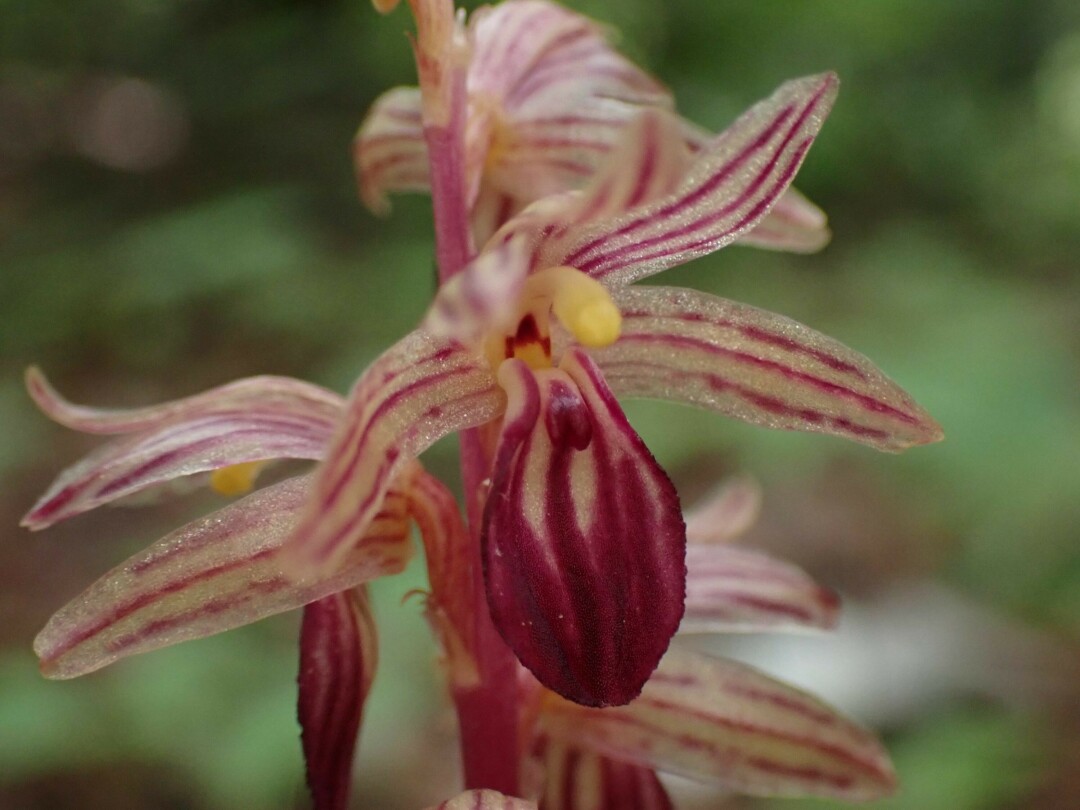A new coralroot

The exquisite flowers of striped coralroot derive all of their energy from trees, through a fungal conduit. Photo by Emily Stone.
Thickets of balsam fir and hemlock crowded along the wide, flat trail, cocooning us in their shade. Sunshine beckoned up ahead, and wetlands filled many swales.
The Sturgeon Bay Ship Canal Nature Preserve in Door County protects unique habitats and allows access on lovely trails.
“Oh look!” exclaimed Karen, as she knelt to take a closer look at a delightful stalk of raspberry-striped flowers. On each of the dozen flowers, five graceful petals and sepals fanned out above a plump, pear-shaped lower lip. The upper petals seemed to be made of frosted glass with dark pink stripes, while the lip was deeply blushing with white highlights. Even the stem was purple.
One color was conspicuously absent from this plant: green.
We knew them right away as striped coralroot. These orchids don’t have leaves or roots. Instead, their coral-like underground stem, called a rhizome, connects with fungi in the soil and steals all the nutrients the flower needs for survival.
The network extends beyond, because the fungi are also partnering with trees. That relationship is more reciprocal, with the fungi providing water and nutrients to the tree and the tree feeding sugars to the fungi.
Once the coralroot taps into the pipeline, they get sugars from the tree through the fungi, as well as nitrogen, without giving their partners anything in return.
This mode of acquiring energy is known as myco-heterotrophy. All of the Earth’s 30,000 orchid species rely on fungi to provide energy for their dust-like seeds to germinate and grow.
Most species eventually sprout green leaves and start making some of their own food, but even they may continue to supplement with nutrients from fungi.
At least 100 orchid species are like striped coralroot and do not photosynthesize at all. This strategy allows orchids to live in deep shade where few green plants can survive.
A minute later, Karen exclaimed again. This time she’d spotted sprigs of spindly chartreuse-yellow plants near the base of a fir tree.
Already a few steps ahead, Coggin found a more robust group of the same flowers. This is what happens when three naturalists go “hiking”!
Coggin Heeringa is a founding naturalist at Crossroads at Big Creek, a local nature center. Karen Newbern was the naturalist for Clayton County, Iowa, when I was growing up there. Before moving to Door County, she taught me how to touch snakes and dissect owl pellets.
These two friends were the perfect guides for my first experience on the Door Peninsula!
Karen’s iNaturalist app confirmed what we’d suspected. This was a type of coralroot orchid, too. The fleshy stem bore no leaves, just a sprig of beautiful little flowers on the upper half.
Each blossom looked like a whimsical elf. One greenish sepal stuck up straight and resembled a head, while two matching ones drooped below like bowlegs. A roundish white petal formed a pot belly, and two small petals the same green as the sepals looked like arms about to pat that belly.
The flower column, hosting a reddish stigma, nestled right where her little heart should be.
Even though I can’t remember ever finding this flower in the woods before, I recognized it from a photo a museum member sent me the previous week. She’d found the orchid with buds still tightly closed, and I’d helped her identify them as Early or Northern or Yellow Coralroot (pick your favorite!) using iNaturalist.
After snapping many photos, we hurried on. Karen and Coggin are also co-chairs of the Education Committee for the Wild Ones Chapter in Door County, and they’d invited me to give my “Finding the Stories in Nature” talk at Crossroads that evening. We couldn’t all three be late!
Once home, I had to investigate this new coralroot. While the rest of the dozen or so members of the Corallorhiza genus grow only in North America, Northern Coralroot is circumboreal. This means they occur all around the top of the globe, from Canada, to Russia, China, Japan, Korea, India, Nepal and almost every country in Europe!
They even occur south of their current main range as “glacial relicts” in cool micro-habitats leftover from the last ice age.
Perhaps it’s their other unique trait that grants them the ability to travel. Northern Coralroot contains three orders of magnitude more chlorophyll than other coralroots, and they manufacture a good portion of their own sugar through photosynthesis. The rest of their nutrients come through parasitizing fungi in the genus Tomentella.
Coralroots exist underground for much of their lives, and their flowering stalk may not pop up every year, or in the same place. So, while widespread and not uncommon, coralroots can be hard to spot – or at least that’s my excuse for never having seen one before this year! Their lifestyle makes coralroots difficult to cultivate, and they won’t survive an attempt to transplant them into your garden. Plus, it’s illegal to dig or pick orchids on most public land.
Back in Cable, Sarah, the museum’s new Summer Naturalist Intern, asked about the highlights of my trip. When I mentioned seeing a beautiful new coralroot, they pulled a photo up on their phone, taken near the staff house over the weekend, and asked “like this one?” I couldn’t believe it! Even shade-loving Northern Coralroots are having their moment in the Sun.
Emily M. Stone is Naturalist/Educator at the Cable Natural History Museum. Her award-winning second book, Natural Connections: Dreaming of an Elfin Skimmer, is available to purchase at cablemuseum.org/books and at your local independent bookstore, too. For more than 50 years, the Cable Natural History Museum has served to connect you to the Northwoods.
